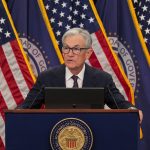
- Federal Reserve
- Interest Rates
- Monetary Policy
Federal Reserve Moves Cautiously With 25 Basis Point Rate Cut
7 minute read

The Federal Reserve delivers its second consecutive 25-basis-point cut, halts balance sheet runoff, and pivots toward protecting employment amid moderating inflation.
Key Takeaways
- Second Straight Cut Amid Labor Softening: The FOMC lowers the federal funds rate by 25 basis points to 3¾–4%, explicitly citing heightened downside risks to employment as job gains decelerate and unemployment edges higher.
- Quantitative Tightening Winds Down: Balance sheet normalization halts December 1, freeing up approximately $60 billion in monthly liquidity to ease potential money market strains.
- Data Rules the Day: Future policy hinges on incoming information, with projections pointing to one additional trim this year and a neutral rate around 3%, balancing persistent inflation against employment vulnerabilities.
Washington, October 29, 2025 — In a measured response to gathering clouds over the labor market, the Federal Open Market Committee (FOMC) on Wednesday lowered its target range for the federal funds rate by a quarter percentage point, to 3¾ to 4 percent. This marks the second such adjustment in as many meetings, a pivot that underscores the central bank’s growing attentiveness to downside risks to employment even as inflationary pressures linger.
A Dual-Mandate Tightrope
The decision, announced at 2:00 p.m. EDT following the two-day gathering of October 28-29, arrives at a juncture of evident tension in the U.S. economy’s dual pillars. Available indicators point to economic activity expanding at a moderate clip, a step down from the more vigorous pace of prior quarters. Job gains, once robust, have decelerated markedly this year; the unemployment rate has inched higher yet holds below levels that would signal distress — at least through August. Subsequent data have aligned with this softening trajectory. Meanwhile, inflation has ticked upward since the spring, settling at levels the Committee deems “somewhat elevated,” a subtle but telling shift from the disinflationary momentum that dominated earlier narratives.
This latest statement from Chair Jerome H. Powell and his colleagues reveals a subtle recalibration of priorities. Downside risks to employment rose in recent months,” the FOMC noted explicitly — language absent from the September missive, which itself flagged a similar but less emphatic shift. Uncertainty pervades the outlook, the Committee affirmed, binding it to its dual mandate of maximum employment and 2 percent inflation.
Mechanics of Monetary Easing
The rate reduction, paired with a plan to halt the drawdown of its vast securities portfolio on December 1, reflects a proactive stance: easing liquidity constraints while nudging policy toward what officials view as neutral territory.
To appreciate the mechanics, consider the implementation details released concurrently. The interest rate on reserve balances falls to 3.90 percent, the overnight reverse repurchase agreement facility to 3.75 percent, and the primary credit rate to 4.00 percent — all effective October 30. These adjustments ensure the federal funds rate trades snugly within the new corridor.
Critically, the balance sheet normalization concludes with Treasury redemptions ceasing entirely come December, while agency mortgage-backed securities proceeds shift to Treasury bills. This caps quantitative tightening (QT) after years of methodical runoff, freeing up roughly $60 billion monthly in liquidity and averting potential strains in money markets.
Labor Market: The Decisive Pivot
The “why” here is rooted in a confluence of data points that, while not screaming recession, whisper of vulnerability. September’s projections — the most recent available — penciled in 2025 real GDP growth at a subdued 1.6 percent median, with unemployment cresting 4.5 percent by year-end before easing marginally. PCE inflation, the Fed’s preferred gauge, was seen holding at 3.0 percent for the year, with core readings at 3.1 percent — figures that, post-release, have proven prescient amid August’s uptick to 2.7 percent headline and 2.9 percent core year-over-year. Consumer prices, per the BLS, mirrored this stickiness at 2.9 percent through August.
Yet the labor market’s deceleration demands precedence. Payroll growth has halved from peak velocities, and while the jobless rate remains historically low, forward indicators — initial claims, quits rates, and small-business hiring sentiment — suggest momentum waning. The FOMC’s readiness “to adjust the stance of monetary policy as appropriate if risks emerge” signals no dogmatic path; future moves hinge on “incoming data, the evolving outlook, and the balance of risks.”
Internal fissures add texture to this portrait. The vote split 10-2, with Stephen I. Miran — a freshly minted Board Governor — again dissenting for a half-point slash, as he did in September. Jeffrey R. Schmid, President of the Kansas City Fed, broke hawkishly, preferring stasis to guard against reigniting prices. Such crosscurrents, rare in recent cycles, illuminate a Committee grappling with asymmetric threats: Miran’s urgency underscores employment perils, Schmid’s caution the inflation backdraft.
Ripples for Markets and Policy
What does this mean for the republic of markets and Main Street? For investors, the cut — modest yet confirmatory — buttresses risk assets. Equities, already buoyant on prior easing, stand to benefit from cheaper capital, while fixed income rallies on compressed yields. The QT terminus mitigates tail risks of reserve scarcity, stabilizing short-term funding. Corporates face lower borrowing costs, potentially spurring capex deferred amid higher rates.
Broader implications ripple through policy interstices. Households, burdened by lingering mortgage rates above 6 percent, glean relief in variable-rate debt and credit card balances. Yet the Fed’s commitment to 2 percent remains ironclad; should inflation reaccelerate — say, via supply shocks or wage spirals — restraint could resume briskly. The September dot plot envisioned the funds rate at 3.6 percent by December 2025, implying perhaps one more trim this year, converging toward a 3 percent longer-run neutral.
Globally, a softer dollar eases emerging-market pressures, though U.S. primacy in yields keeps the greenback resilient. For policymakers, the maneuver validates the post-pandemic framework: flexible targeting amid shocks. Powell, architect of this era’s inflation vanquishing, now stewards a “risk-management” phase.
The Contingent Path Forward
Challenges persist. Fiscal profligacy, geopolitical fissures, and productivity enigmas cloud the horizon. The Beige Book’s October distillation, released mid-month, echoed district reports of moderating demand and easing wage pressures, yet pockets of price persistence in services. If labor fragility deepens — unemployment breaching 4.7 percent, say — the FOMC’s December conclave could accelerate. Conversely, a hot jobs print or PCE spike might pause the pedal.
In essence, Wednesday’s action embodies the art of central banking: balancing proximate perils against distal ideals. The Fed has traversed from emergency hikes to judicious easings, amassing scars from 2021’s inflation misprision. This 50 basis points excised since September nudges policy accommodative, buying insurance against slump without complacency on prices. For senior stewards of capital — the institutional reader — the message rings clear: vigilance endures, data reigns, and the path, though illuminated, remains contingent.







